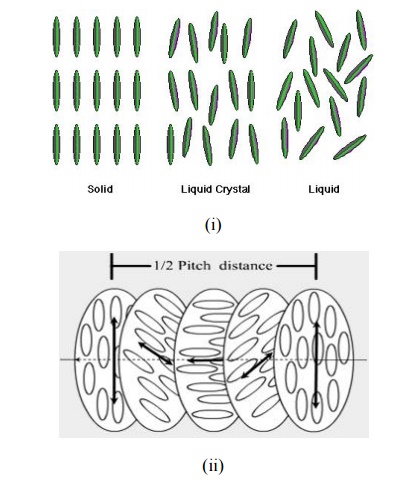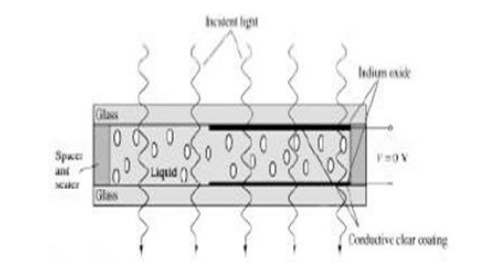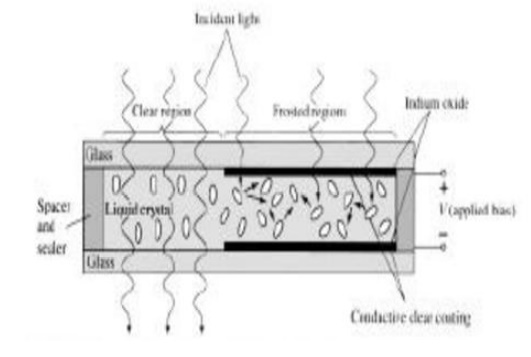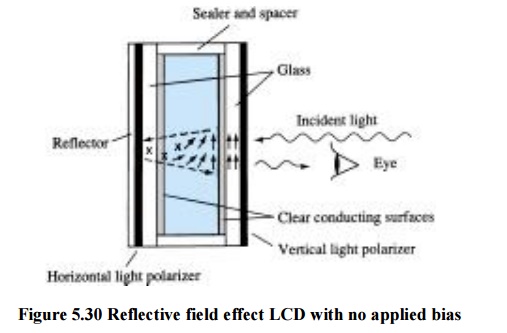Chapter: Electronic Devices : Power Devices and Display Devices
Liquid-Crystal Displays (LCD)
LIQUID-CRYSTAL DISPLAYS (LCD)
Liquid
crystal cell displays (LCDs) are used in similar applications where LEDs are
used. These applications are display of numeric and alphanumeric characters in
dot matrix and segmental displays.
The LCDs
are of two types :
·
Dynamic scattering type and
·
Field effect type.
The liquid
crystal material may be one of the several organic compounds which exhibit
optical properties of a crystal though they remain In liquid form. Liquid
crystal is layered between glass sheets with transparent electrodes deposited
on the inside faces. When a potential is applied across the cell, charge
carriers flowing through the liquid disrupt the molecular arrangement and
produce turbulence.
When the
liquid is not activated, it is transparent. When the liquid is activated the
molecular turbulence causes light to be scattered in all directions and the
cell appears to be bright. The phenomenon is called dynamic scattering.
The
construction of a field effect liquid crystal display is similar to that of the
dynamic scattering type, with the exception that two thin polarizing optical
filters are placed at the inside of each glass sheet. The liquid crystal
material in the field effect cell is also of different type from that employed
in the dynamic scattering cell.
The
material used is twisted nematic type and actually twists the light passing
through the cell when the latter is not energized. This allows the light to
pass through the optical filters and the cell appears bright. When the cell is
energized, no twisting of light takes place and the cell appears dull.
Liquid
crystal cells are of two types. (i) Transmittive type and (ii) Reflective type.
In the
Transmittive type cell, both glass sheets are transparent, so that light from
a rear source is scattered in the forward direction when the cell is activated.
The
reflective type cell has a reflecting surface on one sid e of glass sheets. The
incident light on the fr ont surface of the cell is dynamic ally scattered by
an activatedcell. Both types of cells appear quite bright when activated ev en
under ambient light conditions.
The
liquid crystals are light reflectors or transmitters and t herefore they
consume small amounts of energy (unlike light generators). Unlike LEDs which ca
n work on d.c. the LCDs require a.c. voltage supply. A typical voltage supply
to dynamic scatterin g LCD is 30 V peak to peak with 50Hz.
The
liquid-crystal dis play (LCD) has the distinct advantage of having a lower
power requirement than the LED. It is typically in the order of microwatts for
the display, as compared to the same order of milliwatts for LEDs. It does,
however, require an e xternal or internal light source and is limited to a tem
perature range of about 0° to 60°C. Lifetime is an area of concern because LCDs
can chemically degrade. The types receiving the major inte rest today are the
field-effect and dynamic-scattering units.

Figure 5.24 Schemmatic arrangements of molecules in liquid crystal (i)Nematic, (ii) Cholesteric
A liquid crystal is a m aterial (normally organic
for LCDs) that will flow like a liquid but whose molecular structure has some
properties normally associated with solids.
For the light-scatterin g units, the greatest
interest is in the nemati c liquid crystal, having the crystal structure shown
in Figure 5.27

Figure 5.27 Nematic liquid
crystal with no applied bias

Figure 5.28 Nematic liquid crystal with applied bias
The field-effect or twisted nematic LCD has the
same segment appearance and thin layer of encapsulated liquid crystal, but its
mode of operation is very different.
Similar to the dynamic- scattering LCD, the
field-effect LCD can be operated in the reflective or transmissive mode with an
internal source.
The
transmissive display appears in Figure 5.29 The internal light source is on the
right, and the viewer is on the left.

Figure 5.29 Transmissive field
effect LCD with no applied bias
The reflective-type field-effect LCD is shown in
Figure 5.30 In this case, the horizontally polarized light at the far left
encounters a horizontally polarized filter and passes through to the reflector,
where it is reflected back into the liquid crystal, bent back to the other
vertical polarization, and returned to the observer.
If there
is no applied voltage, there is a uniformly lit display. The application of a
voltage results in a vertically incident light encountering a horizontally
polarized filter at the left, which it will not be able to pass through and
will be reflected.

Figure 5.30 Reflective field
effect LCD with no applied bias
Advantages of LCD
·
Low power is required
·
Good contrast
·
Low cost
Disadvantages of LCD
·
Speed of operation is slow
·
LCD occupy a large area
·
LCD life span is quite small, when used on d.c.
Therefore, they are used with a.c. suppliers.
Applications of LCD
·
Used as numerical counters for counting production
items.
·
Analog quantities can also be displayed as a number
on a suitable device. (e.g.) Digital millimeters.
·
Used for solid state video displays
·
Used for image sensing circuits.
·
Used for numerical display in pocket calculators.
Related Topics